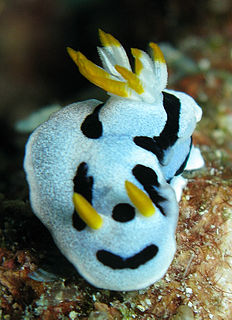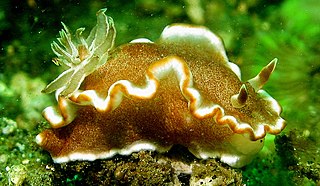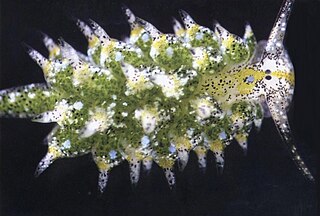
The umbrella slug is a species of large sea snail or limpet, a marine gastropod mollusc in the family Umbraculidae. It is found in tropical to warm temperate parts of the Indo-Pacific and Atlantic Oceans, where it feeds on sponges.

Nembrotha lineolata is a species of nudibranch, a sea slug, a marine gastropod mollusk in the family Polyceridae. It is found in shallow water in the Indo-Pacific. It was first described in 1905 by the Danish malacologist Rudolph Bergh. The type locality is Selayar Island, Indonesia.

Chromodoris lochi, common name Loch's chromodoris, is a species of colourful sea slug, a dorid nudibranch, a marine gastropod mollusk in the family Chromodorididae.

Chromodoris dianae is a species of sea slug, a dorid nudibranch, a shell-less marine gastropod mollusc in the family Chromodorididae.

Glossodoris rufomarginata, commonly called white-margin sea slug or caramel nudibranch, is a species of colourful sea slug, a dorid nudibranch, a marine gastropod mollusc in the family Chromodorididae.

Thuridilla is a genus of sacoglossan sea slugs, shell-less marine opisthobranch gastropod mollusks in the family Plakobranchidae.

Mexichromis pusilla is a species of sea slug or dorid nudibranch, a marine gastropod mollusk in the family Chromodorididae.

Elysia diomedea is a species of sea slug, a marine gastropod mollusc in the family Plakobranchidae.

Thuridilla gracilis is a species of sea slug, a sacoglossan, a marine gastropod mollusk in the family Plakobranchidae. It is an Indo-Pacific species that lives in or near coral reefs and eats algae.

Cerberilla africana is a species of sea slug, an aeolid nudibranch, a marine heterobranch mollusc in the family Aeolidiidae.
Aplysia morio, the Atlantic black sea hare or sooty sea hare, is a species of sea slug, a marine gastropod mollusk in the family Aplysiidae, the sea hares. It lives in warm waters in the Caribbean Sea and off the south and southeastern coast of the United States, where it feeds on seaweed.

Phyllidiella striata is a species of sea slug, a dorid nudibranch, a shell-less marine gastropod mollusc in the family Phyllidiidae. This nudibranch has a black dorsum with longitudinal grey-pink ridges. These ridges are tuberculate and somewhat broken. They form a circle behind the anus and a patch between the rhinophores. The rhinophores are black.

Costasiella ocellifera is a small species of sea slug, a shell-less marine gastropod mollusk in the family Costasiellidae. Costasiella ocellifera, and other members of the Costasiellidae family are often mistakenly classified as nudibranchs because they superficially resemble other species of that group, but they are actually a part of the Sacoglossa superorder of sea slugs, also known as the “sap-sucking sea slugs,” "crawling leaves" or the "solar-powered sea slugs." C. ocellifera was discovered by Simroth in 1895, and was initially classified as Doto ocellifera. The Brazilian species, Costasiella liliana, is a synonym of C. ocellifera.Costasiella ocellifera shows long-term retention of functional kleptoplasty.
Janolus flavoanulatus is a sea slug species. The specific name is derived from Latin words flavus (“yellow”) and anulatus (“ringed”). These soft-bodied mollusks are known for their extraordinary colors and prominent forms. The first description of this species was reported by researcher Terry Gosliner, a leading researcher in the evolutionary history of nudibranchs. Upon his conducted research in the Philippines, Gosliner named Janolus flavoanulatus for its yellow ring around its cerata.

Berthellina citrina, the orange gumdrop, is a species of sea slug in the family Pleurobranchidae. It is found in rock pools in the intertidal zone and in shallow water in the tropical and subtropical Indo-Pacific region.

Philinopsis speciosa, the blue-lined philinopsis, is a species of sea slug, a shell-less opisthobranch gastropod mollusc in the family Aglajidae. It is native to the Indo-Pacific region.

Tubulophilinopsis gardineri, the Gardiner’s philinopsis, or Gardiner's headshield slug is a species of sea slug, a shell-less opisthobranch gastropod mollusc in the family Aglajidae. It is native to the Indo-Pacific region.
Berthellina edwardsii is a species of sea slug, a gastropod mollusc in the family Pleurobranchidae. It is native to the northeastern Atlantic Ocean and the Mediterranean Sea.
Philinopsis depicta is a species of sea slug, a shell-less opisthobranch gastropod mollusc in the family Aglajidae. It is native to the Mediterranean Sea where it lives on the sandy seabed in shallow water. It is a predator.

Thuridilla vataae is a species of sacoglossan sea slug, a shell-less marine opisthobranch gastropod mollusc in the family Plakobranchidae. It is native to the tropical Indo-Pacific. It was first described by the French zoologist Jean Risbec in 1928, its specific name referring to the Bay of Anse Vata, just south of Nouméa, New Caledonia, where the type specimen was collected.
















